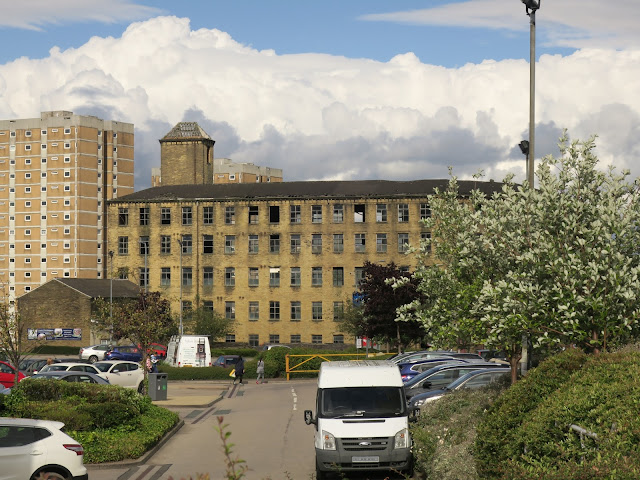 |
| Coming up this hill one is always looking into the light so grey dominates - and lines - and silhouettes. |
What was unfamiliar is rapidly becoming part of the everyday. For much of the time now, I'm not much aware of the contrast between Halifax and Dorset. Perhaps the only thing which is particularly startling is that large patches in the hills around are turning purple as the heather flowers. You can see them from town.
What I haven't quite got used to yet, is the number of straight lines, especially the vertical. There's no point in listing them. You can see!
Contrast this with what I've been used to for more than the last twenty years which is lines curvaceous, horizontal and on the move. Admittedly, the masts of boats are vertical. But they sway, so however neat they are, however firmly attached to their buoys, they are never entirely parallel. They don't have the stolidity of the spire and minaret and railings in the first photo!
In contrast with urban Halifax, the lines which dominate 'my' bit of the Dorset coast are definitely and predominantly horizontal. The horizon itself. Portland Harbour Wall, the white foam streaks, the boat decks, the cliffs. (Chesil Beach.) And these horizontals tend to curve; the wavy waves, the rippling cliffs.
If we were to look out to sea, even the horizon is curved; and if I were to turn round in this picture, I'd be facing straight into a hedge, the broad line of which is irregularly horizontal. The function of a hedge is much the same as railings but in a hedge not a single shape is repeated And nearly everything is non-stoply on the move. Nothing is fixed. Nothing rigid. And for every upright tree trunk there are masses of sideways(ish) branches. Some young hedgerow leaves (say elder) grow upright but once they've got going they tend, elegantly, to stretch sideways. I may be exaggerating - but you'll see the point. Apart from pine needles, glossy leaved plants and succulents (which don't tend to live in hedgerows) hedgerow leaves are likely to be in trouble if they are hanging straight down.
If we were to look out to sea, even the horizon is curved; and if I were to turn round in this picture, I'd be facing straight into a hedge, the broad line of which is irregularly horizontal. The function of a hedge is much the same as railings but in a hedge not a single shape is repeated And nearly everything is non-stoply on the move. Nothing is fixed. Nothing rigid. And for every upright tree trunk there are masses of sideways(ish) branches. Some young hedgerow leaves (say elder) grow upright but once they've got going they tend, elegantly, to stretch sideways. I may be exaggerating - but you'll see the point. Apart from pine needles, glossy leaved plants and succulents (which don't tend to live in hedgerows) hedgerow leaves are likely to be in trouble if they are hanging straight down.
But here . . . if I turn round to see what's behind me, I find this. In the photo at the top of this post, for all its starkness there are wild plants. (I doubt many of you will have noticed and we can come back to them another time.). With a 180 degrees swivel, we find the usual, regulated, car-park planting: an uneventful tree and boring bushes and low growing stuff that's easily trimmed back or never does much in the first place. So although it's greener, it's more 'urban' in the sense of nature being kept at bay.
And beyond the car park there's one of the old mills I've been telling you about with broken windows, collapsing roof.
We'll go a bit closer. I don't know what the circular, red, stunted chimney thing is but earlier in the year there were pretty yellow flowers on its plinth. However, predictably, wherever there's an empty space there's also buddleia. And there it is on its pedestal. For all that we're getting brickier, we're also getting wilder.
But you ain't seen nothing yet.
Down the hill and around the corner a bit and looking up at the roof of the same mill there's more buddleia. Willow-herb too. Now look at the windows on the top left. This is where it gets scary. Really scary. There's a tree sticking out of the one second from the left. An odd place for a tree or a large bush but at least it has breathing space. But behind the very top left window is one of the scariest, creepiest things I've ever seen.
It's so horrid I have to look away. A buddleia, in flower, but completely trapped. It's hit the glass and can go no further. It's as if alien hands are pressing and sliding and scrabbling to get out and all the while can't stop growing so it's squashed further and further into itself by its own self. An image of claustrophobia. Aaaaaaaagh. I like everything about my new home except this.


















